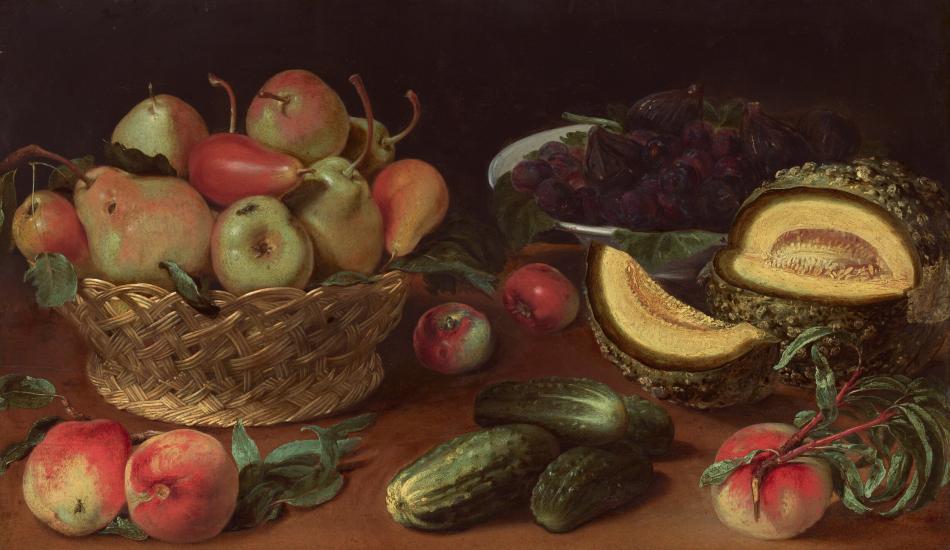Still Life with Apples, Pears, Cucumbers, Figs, Plums, and a Melon
c. 1625 - 1630
Artist, Italian, c. 1578 - c. 1630
Fede Galizia
Attributed to

Fede Galizia (documented 1587–1630), whose work was overlooked for four centuries, is now known for her luminous and striking naturalism. The National Gallery of Art has acquired Still Life of Apples, Pears, Cucumbers, Figs, and a Melon (c. 1625–1630), a late work by the artist. This acquisition not only increases the National Gallery’s holdings of women artists and still-life paintings from this period, but also creates an important dialogue with contemporary Spanish still lifes, including works by Juan van der Hamen y León and Luis Egidio Meléndez.
Galizia was the daughter and pupil of miniaturist and metalworker Nunzio Galizia. She painted portraits and devotional subjects, but she is most famous today for her still lifes. She made her career in Milan, a center of Counter-Reformation religious fervor and scientific inquiry.
While many of Galizia’s earlier still-life paintings focus on a single bowl of fruits and flowers, Still Life of Apples, Pears, Cucumbers, Figs, and a Melon celebrates the varied bounty of the natural world. An extremely skilled and detailed still life, the painting inspires the viewer to meditate on the splendor of nature. In the early modern period, such a work would have held both religious and scientific significance, allowing the viewer to be spiritually moved as well as marvel at the new scientific discoveries made possible by the recent invention of the microscope.
Artwork overview
-
Medium
oil on panel
-
Credit Line
Gift of Funds from Roger Sant, Patrons’ Permanent Fund, and Gift of Funds from Deborah Burklund
-
Dimensions
overall: 35.3 × 59.1 cm (13 7/8 × 23 1/4 in.)
framed: 51 × 75 × 7 cm (20 1/16 × 29 1/2 × 2 3/4 in.) -
Accession Number
2023.3.2
More About this Artwork

Article: Three Women Artists You May Not Have Heard Of
Meet the 17th-century painters Fede Galizia and Gesina Ter Borch. And see the only known work by Caterina Angela Pierozzi.
Artwork history & notes
Provenance
Possibly Cardinal Cesare Monti [1594 –1650], Milan;[1] Possibly by descent to his cousin Giulio Monti [c.1604 -1686], Count of Valsassina, Milan, in 1650; Possibly Count Cesare Monti Melzi [d. 1741], Palazzo Monti (later known as Palazzo Sormani-Andreani and Verri), Milan; Possibly by descent to his family.[2] Infante Don Sebastián Gabriel Borbón y Braganza [1811 –1875], Pau.[3] Calini family Brescia, since c.1900; acquired December 2020 by (P. & D. Colnaghi & Co., Ltd, London); Purchased 2022 by NGA.
[1] Provenance adapted from Colnaghi catalogue entry; copy in NGA curatorial records.
[2] This is suggested by a note in an inventory conducted the year after the Count’s death.
[3] Crowned SG cyphers on the reverse of the painting attest to the Infante’s ownership.
Associated Names
Bibliography
2023
Straussman-Pflanzer, Eve. "Gifts and Acquisitions." Art for the Nation no. 67 (Fall 2023): 18-19, repro.


